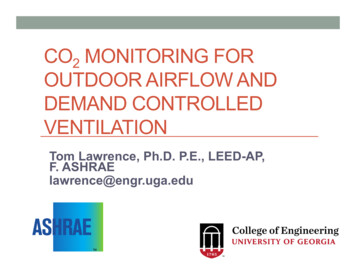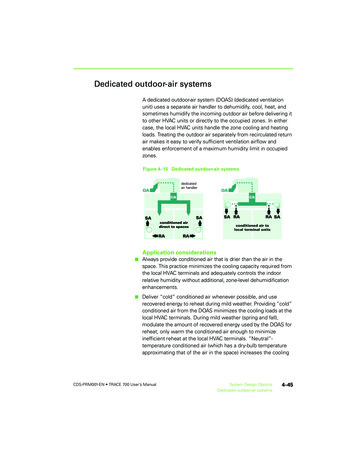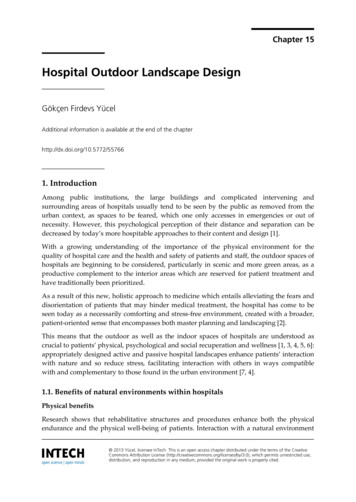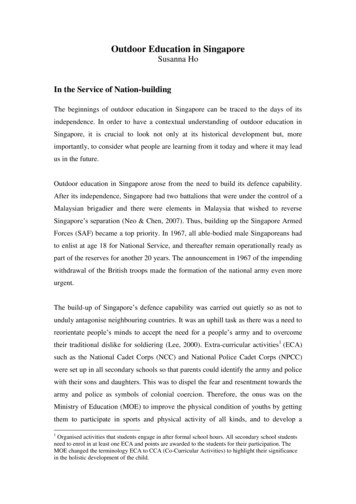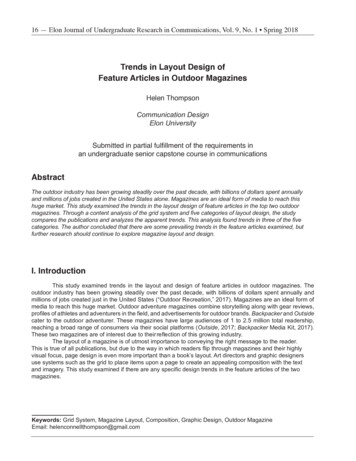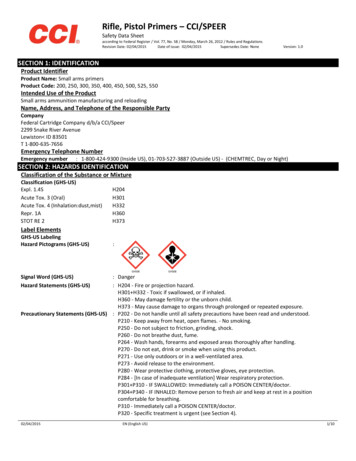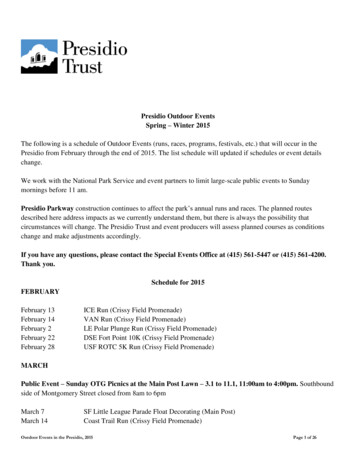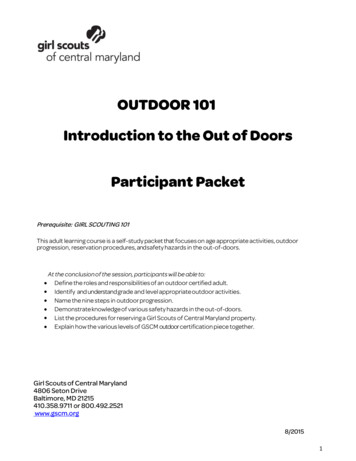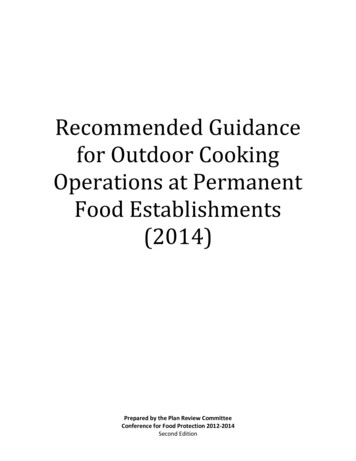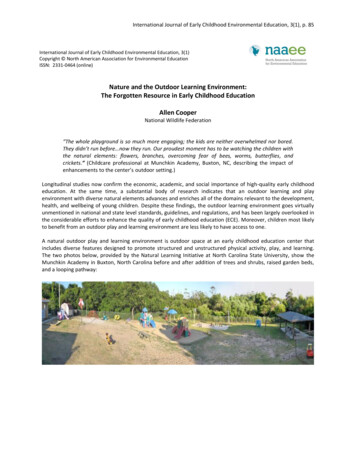
Transcription
International Journal of Early Childhood Environmental Education, 3(1), p. 85International Journal of Early Childhood Environmental Education, 3(1)Copyright North American Association for Environmental EducationISSN: 2331-0464 (online)Nature and the Outdoor Learning Environment:The Forgotten Resource in Early Childhood EducationAllen CooperNational Wildlife Federation“The whole playground is so much more engaging; the kids are neither overwhelmed nor bored.They didn’t run before now they run. Our proudest moment has to be watching the children withthe natural elements: flowers, branches, overcoming fear of bees, worms, butterflies, andcrickets.” (Childcare professional at Munchkin Academy, Buxton, NC, describing the impact ofenhancements to the center’s outdoor setting.)Longitudinal studies now confirm the economic, academic, and social importance of high-quality early childhoodeducation. At the same time, a substantial body of research indicates that an outdoor learning and playenvironment with diverse natural elements advances and enriches all of the domains relevant to the development,health, and wellbeing of young children. Despite these findings, the outdoor learning environment goes virtuallyunmentioned in national and state level standards, guidelines, and regulations, and has been largely overlooked inthe considerable efforts to enhance the quality of early childhood education (ECE). Moreover, children most likelyto benefit from an outdoor play and learning environment are less likely to have access to one.A natural outdoor play and learning environment is outdoor space at an early childhood education center thatincludes diverse features designed to promote structured and unstructured physical activity, play, and learning.The two photos below, provided by the Natural Learning Initiative at North Carolina State University, show theMunchkin Academy in Buxton, North Carolina before and after addition of trees and shrubs, raised garden beds,and a looping pathway:
International Journal of Early Childhood Environmental Education, 3(1), p. 86This article lays out recommendations for increasing the availability and use of natural outdoor play and learningenvironments in order to improve the quality of ECE. The article begins with a summary of research indicating thecontribution of an outdoor learning environment to the domains of ECE; describes the current policy related to theoutdoor learning environment and nature exploration in state regulations; identifies model policy content in keyareas; and concludes with specific actions that will increase availability of quality outdoor learning environments.Benefits of Natural Outdoor Play and Learning Environments Improves self-regulation Advances physical fitness and gross motor development Improves nutrition Improves eyesight Promotes cognitive development Improves academic performance Lessens the symptoms of ADHD and improves concentration Promotes self-confidence Builds understanding and appreciation of ecosystems, food systems, and environmental processesProposed Minimum Standards to Promote Quality Natural Outdoor Learning Environments Formally designate the outdoor space an outdoor play and learning environment or similar The outdoor play and learning environment has at least two outdoor gross motor features (e.g., climbingfeatures or looping pathways) The outdoor play and learning environment has at least two outdoor learning settings (e.g., gardening area,loose parts station, or dramatic play area) The outdoor play and learning environment includes a diverse selection of plants and habitats representativeof local flora and fauna The outdoor play and learning environment includes natural features that enrich children’s play and learningsuch as: non-toxic trees, shrubs, or vines; topographic variations (such as mounds, terraces, slopes); a varietyof ground surfaces (mulch, grass, pebbles); smooth rocks, wood or logs; non-poisonous flowering plants orgarden plants and vegetables; birdfeeders, bird baths and birdhouses An outdoor water source for irrigation is available The outdoor play and learning environment has a looping pathway and wheeled toys At least 30 minutes of outdoor time is offered per three hours at the center. Consumption of fruits and vegetables grown on site is expressly allowed A nature supplement for early learning guidelines is adopted Professional development for enhancing and utilizing the outdoor play and learning environment is provided Each center has outdoor space of at least 75 sq. ft. per child, with exemptions granted only if daily walkingoutings to nearby parks or public spaces are provided
International Journal of Early Childhood Environmental Education, 3(1), p. 87Strong evidence that nature inquiry and outdoor learning environments advance the goals of ECEECE programs are expected to foster the physical, mental, and social-emotional development of children, and,increasingly, to address an array of threats to American children’s health and wellness.The prevalence of overweight children ages 6 to 11 has more than doubled in the last 20 years, increasing to 18.8%in 2004, and the rate among adolescents has more than tripled (CDC 2007). Overweight and obese children sufferfrom a myriad of health problems, including higher risks of cardiovascular disease, diabetes, bone and jointproblems, and sleep apnea (Ogden 2006). These health problems are so severe that researchers warn of thepossibility that for the first time in American history, life expectancy may actually decrease because of the healthimpacts of the current childhood obesity epidemic (Olshansky et al 2005).In the area of mental health, approximately 11% of children have been diagnosed with AttentionDeficit/Hyperactivity Disorder (ADHD) with the rates of diagnosis increasing 5% per year from 2006 to 2011 (CDC2014).School readiness is seen as a growing responsibility in ECE, and the K-12 standards movement has had a substantialimpact on ECE, with virtually every state and territory adopting Early Learning Guidelines which specify desired ECElearning and development outcomes, often aligned with K-12 standards.If ECE is to contribute to addressing these challenges then all available resources must be mobilized. A growingbody of scientific literature indicates that play and learning in a diverse, natural area provides a wide array ofhealth, learning, gross motor, and mental health benefits for children.Learning and Cognitive Development Promotes Cognitive Development. The “richness and novelty” of being outdoors stimulates brain development(Rivkin 2000). Research shows that “direct, ongoing experience of nature in relatively familiar settings remainsa vital source for children’s physical, emotional, and intellectual development” (Kellert 2004). Proximity to,views of, and daily exposure to natural settings increases children’s ability to focus and enhances cognitiveabilities (Wells, 2000). Improves academic performance. Studies in the US show that schools that use outdoor classrooms and otherforms of nature-based experiential education show significant student gains in social studies, science,language arts, and math. Students in outdoor science programs improved their science testing scores by 27%(American Institutes for Research, 2005).Mental Health, Self-Regulation and Improved Behavior Promotes constructive, imaginative, and collaborative play. Lower quality outdoor environments areassociated with repetitive play and negative behavior, while higher quality environments are associated withmore constructive play (DeBord, Hestenes, Moore, Cosco, and McGinnis 2005). Natural materials added to theoutdoor environment increase children’s spatial-cognitive awareness, physical competence and skills, andsocialization (Herrington and Studtmann 1998). Inclusion of loose parts of natural materials increasesconstructive and dramatic play (Hannon and Brown 2008.) Improves Self-Regulation and Reduces Stress and Aggression. Time spent in green spaces, including parks, playareas, and gardens, has been shown to reduce stress and mental fatigue (Taylor 2001). In one study childrenwho were exposed to greener environments in a public housing area demonstrated less aggression andviolence and less mental stress (Kuo & Sullivan 2001). Just viewing nature reduces physiological stressresponse, increases level of interest and attention, and decreases feelings of fear and anger or aggression(Burdette & Whitaker 2005.) Lessens the Symptoms of ADHD. Spending time outdoors reduces the severity of symptoms of children withADHD. Even short walks in urban parks increase concentration and lessen ADHD related symptoms (Kuo &Taylor 2004, Taylor et al 2001).
International Journal of Early Childhood Environmental Education, 3(1), p. 88 Promotes Self-Confidence and Improves concentration. Children who spent time playing outside are morelikely to take risks, seek out adventure, develop self-confidence and respect the value of nature (UKSDC 2007).Outdoor recreation experiences like camping can improve children’s self-esteem (Marsh 1999). Green spacesoutside the home can increase concentration, inhibition of initial impulses, and self-discipline (Taylor et al2001).Builds Environmental Stewardship Ethic. A number of studies indicate that childhood contact with naturecontributes to shaping a lasting environmental ethic and an interest in environmental professions (Wells &Lekies, 2006). Respondents who had played in wild natural environments were more likely to have positiveperceptions of natural environments and outdoor recreation activities (Bixler & Hammitt 2001).Physical Activity, Nutrition, and Gross Motor Development Advances Physical fitness and Gross Motor Development. Children who play outdoors are generally more fitthan those who spend the majority of their time inside. Children who play outside in natural areas also show astatistically significant improvement in motor fitness with better coordination, balance, and agility (Fjortoft2001). The mere presence (with no additional programming) of an outdoor learning environment with naturalfeatures and a looping pathway is associated with a 22% increase in physical activity (Cosco, Moore, Smith,2014). Children’s physical activity is motivated by diverse outdoor environments (Boldemann et al, 2006) andthe preschool outdoors is a determinant of preschool physical activity (Cardon et al 2008.) Improves nutrition. Children who grow their own food are more likely to eat fruits and vegetables (Bell &Dyment, 2008) and to show higher levels of knowledge about nutrition (Waliczek, Bradley & Zajicek, 2001).They are also more likely to continue healthy eating habits throughout their lives (Morris & Zidenberg-Cherr,2002). Gardens that support children’s engagement with vegetables and fruits and increase frequency ofconsumption are associated with acceptance of diverse tastes (Cabalda et al 2011) as a positive strategy tosupport healthy eating (Meinen et al 2012.) Improves eyesight. More time spent outdoors is related to reduced rates of myopia (nearsightedness) inchildren and adolescents (Rose et al 2008).EXISTING ECE POLICY FRAMEWORK UNDERUTILIZES THE OUTDOOR SPACEDespite the documented benefits, a review of the ECE policy framework at federal and state levels shows a missedopportunity to use the outdoor play and learning environment to advance ECE goals. ECE is governed by a complexand decentralized regulatory structure. All mandatory regulation occurs at the state level, and consists of minimumregulatory requirements, non-mandatory Quality Rating and Improvement Systems (QRIS) which incentivizeimprovements to ECE, and non-mandatory early learning and development guidelines (ELG) which specify desiredlearning and development outcomes. At the national level, there are evaluation tools such as the EnvironmentRating Scale, non-mandatory accreditation systems developed by private organizations such as NationalAssociation for the Education of Young Children (NAEYC), and performance standards for Head Start centers. Areview of each policy body shows virtual absence of policy or incentive related to outdoor learning and natureinquiry, with some exceptions.A. Licensing and Administrative Regulations. State licensing regulations are the minimum standards that everylicensed child care center in a state must meet. These regulations are developed and administered by stategovernments. A separate Natural Start Alliance comprehensive review of state licensing requirements isforthcoming, so in this article only two states—Florida and North Carolina—are contrasted in the table below todemonstrate the variety in regulatory requirements for childcare centers related to outdoor play and learningenvironments. Florida requires 45 square feet of outdoor space per child--with a broad exemption for centersdesignated urban—and no outdoor programming requirements. North Carolina, by contrast, requires a minimum75 square feet per child, with no exemption, as well as outdoor time and programming requirements. NorthCarolina includes additional requirements for regular outdoor time and expressly permits the consumption offruits and vegetables grown on-site.
International Journal of Early Childhood Environmental Education, 3(1), p. 89Outdoor space requirementOutdoor space exemptionsOutdoor programmingrequirementFruits and vegetables grown onsiteNorth Carolina75 ft2 per childNoneAt least 30 minutes, and one offour planned activities, outdoorsper day, weather permittingExpressly permitted to eat ifwashedFlorida45 ft2 per childExemption for ‘urban’ centersNo requirementNo mentionRecommended enhancements to Licensing Requirements1. Minimum outdoor space requirement of 75 square feet per child and addition of requirements to enrich theoutdoor space.2. Exemptions for minimum outdoor space only in narrow circumstances, such as when on-site outdoor space isunavailable, and daily off-site walks to nearby parks or public spaces are provided.3. Daily outdoor programming requirement of at least 30 minutes and one planned outdoor activity per day.4. Consumption of site-grown fruits and vegetables expressly allowed.“We are proud of the garden kids planting and picking: greenbeans, red onion, sunflowers,lettuce, carrots, mustard greens,turnip greens, spinach, squash,green peppers, tomatoes, andblueberries.”(Childcare professional)Vegetable gardens provide a context for learning about nature and nutritionB. Quality Rating Improvement Systems (QRIS). Quality rating improvement systems (QRIS) have been used bymany states to improve the quality of child care centers above the minimum level required by licensingregulations. Thirty-five states or localities have quality rating programs. Most quality rating systems are voluntaryprograms where providers are assessed on a variety of standards. Some states then provide financial incentives toprograms that attain higher standards, and publicize the resulting scores, so QRIS becomes a way to improvequality without public mandates. QRIS offer a powerful tool for encouraging provision and use of natural outdoorplay and learning environments beyond levels required by state licensing standards, but a review of 35 QRISstandards shows that few states use QRIS standards for this purpose. Only six states have standards relating toeither provision of daily time outdoors or quality of outdoor learning environments. The remaining states eitherleave the outdoor learning environment unaddressed, or treat it through the Environment Rating Scale, whichoffers only minimum consideration to the outdoor setting (discussed further below.)Michigan’s QRIS has the strongest outdoor time requirement of 30 minutes for every 3 hours and is one of only 5states (IN, NY, MI, OK, WI) with standards related to outdoor time. Oklahoma’s QRIS has a standard requiring dailyoutdoor time, and also has a standard specifying that at least two outdoor learning areas be available. Texas’ QRISis the only one with detailed quality standards for outdoor learning environments.
International Journal of Early Childhood Environmental Education, 3(1), p. 90QRIS Policy DimensionOutdoor time requirementStateIN, NY, MI, OK, WIExemplary LanguageMI: “30 minutes of every 3 hours dedicatedto active outdoor time,with appropriate indoor physical activitiesavailable when weatherprohibits outdoor play”Quality of outdoor spacerequirementIN, OK, TXQRIS contains no requirementsrelating to outdoor space beyondEnvironment Rating Scale or SimilarAR, AZ, CA, CO, DE, GA, IA,ID, IL, KY, MA, MS, MT,NC, ND, NV, OH, PA, SC,TN, VA, WAOK: “A minimum of 2 learning areas areavailable outdoors.”TX: See sidebarN/ARecommended Enhancements to Quality Rating Improvement SystemsBecause Environment Rating Scale does not adequately address the outdoor learning environment, QRIS shouldnot depend exclusively on the ERS to evaluate outdoor settings, as is the case in more than 20 states. QRIS shouldalso include the following specific standards:1.2.3.A standard for minimum time outdoors, weather permitting. The Michigan standard of 30 minutes per 3 hoursof programming is a minimum standard.At least 75 square feet of outdoor learning space per child.Standards for features of outdoor learning environments including a) number of outdoor learning features, b)number of gross motor activity features, including looping pathways, c) natural features in the outdoorenvironment that enrich children’s play and learning such as: Non-toxic trees, shrubs, or vines; topographicvariations (such as mounds, terraces, slopes); a variety of ground surfaces (mulch, grass, pebbles); smoothrocks, wood or logs; non-poisonous flowering plants or garden plants and vegetables; birdfeeders, bird bathsand birdhouses.Wheeled toys and a looping pathway are associated with increases in levels of physical activity
International Journal of Early Childhood Environmental Education, 3(1), p. 91"The children love the trike path and log seating, and building clubhouses with the logs and treecookies: building, stacking, carrying.""Our proudest achievement would have to be the discipline improvement. The kids are not all doingthe same things as each other, instead they are using their imaginations more.""There are more ways for disabled children to play and interact with other children, not justwatching."(Comments from early childhood education professionals)Sidebar: Texas Rising Star Standards Emphasize Nature in the Outdoor Learning EnvironmentIn 2015 Texas Rising Star program guidelines were amended to change the name of the outdoor space from‘playground’ to ‘outdoor learning environment’ and to include the following qualitative elements:1.2.3.4.5.Outdoor environment and activities are linked to and reinforce indoor learning.The outdoor environment provides children with the opportunity to care for living things and appreciatenature/beauty such as: Non-toxic trees, shrubs, or vines; topographic variations (such as mounds, terraces,slopes); a variety of ground surfaces (mulch, grass, pebbles); smooth rocks, wood or logs; non-poisonousflowering plants or garden plants and vegetables; birdfeeders, bird baths and birdhouses.Outdoor environment and natural and manufactured equipment/materials, provides partial shade, motivateschildren to be physically active and engage in active play such as balancing, climbing, crawling, moving,pushing/pulling, riding, walking, and running. Key elements may include: balls, swings, balance beams,climbing structures, tumbling pads, tricycles or riding toys, marching music, jump ropes, space to skip, hop,and roll.Natural outdoor environment supports social emotional development including but not limited to areas thatinvite social gatherings, tummy time, dramatic play, group games, music and movement, and spaces for quietand calm activities. Key elements may include: Natural additions such as boulders, tree stumps, sand area andbenches, design elements such as stages, platforms, wind chimes, canopies, teepees, gazebos.Outdoor equipment/materials encourage infants to experience the environment through all five sensesTexas Rising Star Standards available at ar-programguidelines.pdf last reviewed on 2.13.15)C. Early Learning Guidelines. Early Learning Guidelines (ELG) are the primary tool used by states to influence thelearning and development outcomes produced by early childhood education providers. ELG are voluntaryguidelines which specify desired learning and development outcomes for children of a given age. The prevalence ofELG has increase alongside the standards movement in K-12 education, as more attention is paid to K-12 readiness.In 2002 24 states had adopted ELG, but by 2014 56 states and territories had adopted ELG for children in the 3-5age group. While ELG are not mandatory, virtually every state Quality Rating Improvement System makesreference to them and provides incentives to centers for offering a curriculum aligned with the state ELG. EarlyLearning Guidelines therefore represent the most robust tool for increasing environmental and nature learningoutcomes in early childhood education.A review of 50 state ELG found a wide variation in approaches to ELG and to environmental education content. Thedifference most relevant to the concerns of this paper relate to the degree of detail offered in early learningguidelines. Some states offer ELG that specify general outcomes, which typically are descriptions of something achild will have the capacity to do, whereas other states identify very specific and detailed learning goals that relateto mastery of content. Almost all state ELG only addressed environmental education in the science domain,missing opportunities to use environment to aid learning about place and community and to advance dispositionsto learning such as curiosity, risk-taking, and perseverance. Within the science domain a contrast of the
International Journal of Early Childhood Environmental Education, 3(1), p. 92Washington State and Pennsylvania ELG for science illustrates the disparate approaches to environmental learningcontent.In the Washington State ELG, which takes a capacity approach, science outcomes for 4-5 year olds areencompassed in the following list of what a child should be able to do: Predict what will happen in science and nature experiences. Consider whether these predictions were right,and explain why or why not. Use tools to explore the environment (a magnifying glass, magnets, sifters, etc.). Measure sand or water using a variety of containers. Use one sense (such as smell) to experience something and make one or two comments to describe this. Investigate the properties of things in nature. Begin to understand what various life forms need in order togrow and live. Take responsibility in taking care of living things, such as feeding the fish, watering plants, etc. Talk about changes in the weather and seasons, using common words, such as rainy and windy. Look at where the sun is in the morning, afternoon, evening and night. Take walks outside and gather different types of leaves, name colors he/she sees outdoors. Participate (with adult direction) in activities to preserve the environment, such as disposing of litter properly,saving paper and cans to be recycled, etc.(Source: s/guidelines.pdf)By contrast Pennsylvania’s early learning guidelines offer a robust content approach. The science section alonespans more than 18 pages and has an Environment and Ecology Glossary with 30 terms. The glossary includesterms such as adaptation, aquatic ecosystem, biodiversity, habitat, integrated pest management, non-pointpollution, terrestrial system, and watershed. The Pennsylvania ELG contains by far the most detailedenvironmental content of any state arten.pdf).There is an active debate on whether a capacity or content approach best serves the child learning anddevelopment goals of ECE, depending in large measure on one’s view about which approach is developmentallyappropriate for a child of a given age. Taking a position on the debate is outside the scope of this review, andreaders are directed to the North American Association for Environmental Education’s Early ChildhoodEnvironmental Education Programs: Guidelines for Excellence, and to National Association for the Education ofYoung Children’s position paper on early learning standards. Readers with a content orientation are encouraged toreview the Pennsylvania standards, whereas those with a capacity orientation are encouraged to review theguidelines of Washington State, Montana, or Missouri.Recommended enhancements to Early Learning Guidelines1.2.Use nature and outdoor learning to advance learning goals across all domains, and not just in cognitive andscience development.Develop examples of how to use the outdoor learning environment and natural materials to advance eachlearning goal, following the model of the supplement to the Nebraska Early Learning Guidelines “ConnectingChildren to Nature.”D. Environment Rating Scale. The Environment Rating Scale (ERS) is an influential national measurement tool toassess process quality in an early childhood care group. There are four environment rating scales, each for adifferent age groups and settings: infants and toddlers (ITERS-R), early childhood (ECERS-R), family care (FCCERSR), and school-aged care (SACERS-R), and each scale has items to measure what it considers the three most basicchild needs: 1) Protection of their health and safety; 2) Building positive relationships; and 3) Opportunities forstimulation and learning from experience. The ERS is developed by the Frank Porter Graham Child DevelopmentInstitute at the University of North Carolina at Chapel Hill and is non-binding, but it is the most influential
International Journal of Early Childhood Environmental Education, 3(1), p. 93measurement tool because it has been incorporated by reference by 22 state Quality Rating ImprovementSystems, and in most of these cases, the ERS is the only vehicle for evaluating the outdoor environment.Given the influence of this tool, the Early Childhood Environment Rating Scale-Revised (ECERS-R) was reviewed forcontent related to outdoor environment. The nature and outdoors content of ECERS-R is modest. Three of 43items on the measurement scale relate to nature or the outdoor learning environment, and a center could achievean ‘excellent’ rating with modest outdoor and natural features. (The term ‘environment’ as utilized by ERS refers tothe total care environment, encompassing indoor and outdoor physical environments, programming content andstructure, and interactions.)Recommended enhancement of ERSThe outdoor learning environment and living and natural items are underutilized resources in ECERS-R. Thefollowing environment features should be included in the point scale:(1) At least 30 minutes outdoors per 3 hours in care, weather permitting(2) Point scale incentives for outdoor gross motor features(3) Point scale incentives for outdoor learning stations(4) Point scale incentives for natural features in the outdoor environment that enrich children’s play and learningsuch as: Non-toxic trees, shrubs, or vines; topographic variations (such as mounds, terraces, slopes); a variety ofground surfaces (mulch, grass, pebbles); smooth rocks, wood or logs; non-poisonous flowering plants or gardenplants and vegetables; birdfeeders, bird baths and birdhousesFixed logs provide an opportunity for gross motor activities like jumping, climbing, and balancing"They are learning control and ethics in how they interact with nature: what to pick, what not to pick."“The garden is a kind of therapy to the children from difficult situations and with special needs.”(Comments from early childhood education teachers)E. Head Start Performance Standards. Established in 1965, Head Start promotes school readiness for children inlow-income families by offering educational, nutritional, health, social, and other services. Head Start operates inevery state and serves almost one million children and families, and because of the scale and reach of theprogram, the Head Start Performance Standards are important indicators of quality in eets/docs/hs-program-fact-sheet-2012.pdfThe performance standards recognize an essential role for outdoor time by establishing minimum outdoor spacerequirements and requiring time outdoors for play and gross motor development as well as for learning. Each
International Journal of Early Childhood Environmental Education, 3(1), p. 94center must provide “at least 75 square feet of usable outdoor play space per child,” (1304.53(a)(5), child physicaldevelopment must be promoted by ‘providing sufficient time, indoor and outdoor space, equipment, materialsand adult guidance for active play and movement that support the development of gross motor skills”(1304.21(a)(5)(i)), and a curriculum that “provides individual and small group experiences both indoors andoutdoors” (1304.21(c)(1)(vii)).Recommended enhancementsWhile the Performance Standards recognize the importance of outdoor time, they could be improved by addingthe following specific requirements:1. A standard for minimum time outdoors, weather permitting, such as 30 minutes outdoors per 3 hours at thecenter.2. Standards for features of outdoor learning environments including a) number of outdoor learning features, b)number of gross motor activity features, c) natural features in the outdoor environment that enrich children’s playand learning such as: Non-toxic trees, shrubs, or vines; topographic variations (such as mounds, terraces, slopes); avariety of g
designated urban—and no outdoor programming requirements. North Carolina, by contrast, requires a minimum 75 square feet per child, with no exemption, as well as outdoor time and programming requirements. North Carolina includes additional requirements for regu
